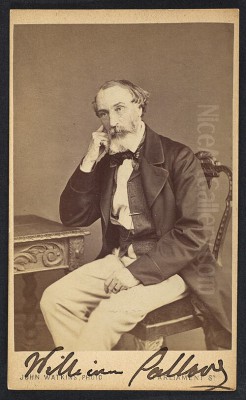
William Callow stands as a significant figure in the history of British art, particularly celebrated for his mastery of the watercolour medium. Spanning a long and productive life from 1812 to 1908, Callow became one of the most respected landscape painters of the Victorian era. His work, characterized by its detailed execution, vibrant colour, and picturesque compositions, captured the landscapes and architecture of Britain and continental Europe, leaving behind a rich visual record of the 19th century. He was also an accomplished printmaker and an influential teacher, connecting the traditions of British watercolour with artistic developments on the Continent.
Early Life and Artistic Beginnings
Born on July 28, 1812, in Greenwich, London, William Callow came from a family connected to the building trades; his father was a builder and carpenter. This practical background perhaps instilled in him an appreciation for structure and form. His artistic inclinations emerged early, and at the young age of eleven, he was apprenticed to the engraver Theodore Fielding. Theodore was part of the notable Fielding family of artists, which also included Copley, Thales, and Newton Fielding. During his apprenticeship, Callow learned the intricate techniques of engraving and aquatint, skills that would inform the precision of his later work. Crucially, it was also under Theodore Fielding that he received his initial training in the art of watercolour painting, laying the foundation for his future career.
The Parisian Sojourn
In 1829, seeking broader artistic horizons, the young Callow moved to Paris. This move proved pivotal in his development. Initially, he found work utilizing his engraving skills, collaborating with the publisher J. F. d'Ovestrand and contributing to topographical publications, a popular genre at the time. Paris was a vibrant artistic hub, and Callow quickly integrated into the community of artists, particularly the circle of British expatriates. He formed a close friendship with Thomas Shotter Boys, another English artist who would become renowned for his picturesque views of European cities. Callow also shared a studio for a time with Boys and Newton Fielding, Theodore's brother, fostering an environment of mutual learning and artistic exchange.
Influences and Early Success in Paris
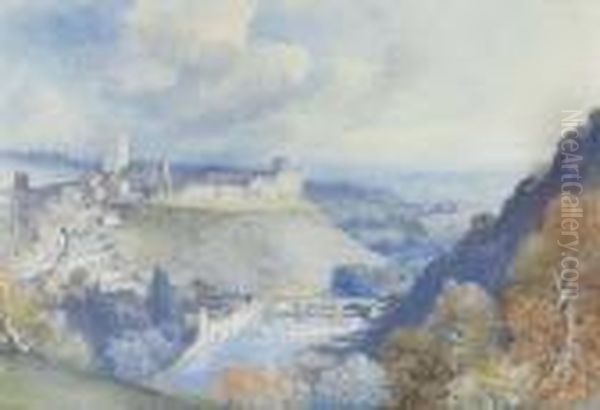
The most significant artistic influence on Callow during his Parisian years was Richard Parkes Bonington. Although Bonington had died tragically young in 1828, just before Callow's arrival, his work, which brilliantly fused English watercolour techniques with French Romantic sensibilities, was highly esteemed. Callow deeply admired Bonington's fluid style, his handling of light, and his choice of picturesque subjects. This admiration shaped Callow's own artistic direction, and Bonington's legacy continued to resonate in Callow's work throughout his long career, helping him maintain a connection to popular taste well into the late 19th century. While Bonington is sometimes mistakenly labelled Neoclassical, his true alignment is with the Romantic movement, a distinction important to understanding his impact on Callow.
Callow's talent did not go unnoticed. He began exhibiting his watercolours at the prestigious Paris Salon. A key moment came in 1834 (some sources suggest earlier submissions, possibly including a version in 1831) when his painting Richmond Hill was shown and received considerable acclaim. This success brought him to the attention of the French royal family. He was engaged to give drawing and watercolour lessons to the children of King Louis-Philippe I, notably the Duke of Nemours and Princess Clémentine. This prestigious patronage significantly enhanced his reputation both in France and back in Britain. His time in Paris established him as a capable and sophisticated artist, comfortable working within both British and Continental artistic circles, alongside French contemporaries like Eugène Isabey.
Return to England and Professional Ascent
In 1841, after twelve formative years in France, Callow returned to London. While he had initially worked in engraving, his focus now shifted decisively towards watercolour painting. He sought to establish himself within the thriving London art scene, particularly within the esteemed Society of Painters in Watercolours (often known as the Old Watercolour Society or OWS). This society was the premier institution for watercolour artists in Britain, boasting members like the established masters David Cox and Peter De Wint, and tracing its lineage back to the pioneering generation influenced by J.M.W. Turner.
Callow's Continental experience and refined technique quickly gained him recognition. He was elected an Associate of the OWS in 1838 (even before his permanent return) and became a Full Member in 1848. Membership conferred significant prestige and provided a vital platform for exhibiting and selling his work. He became a regular and prolific contributor to the Society's annual exhibitions for decades, solidifying his position as one of the leading landscape watercolourists of his generation. His works were admired for their technical skill, appealing subjects, and the distinct blend of topographical accuracy and picturesque sensibility he had honed abroad.
Travels and Inspirations
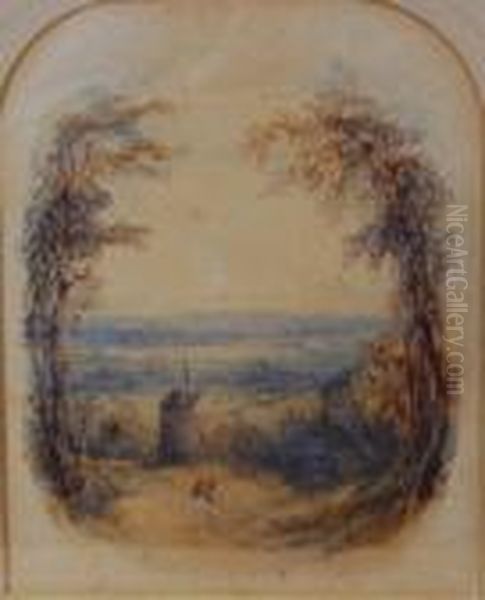
Like many artists of his time, Callow was an avid traveller. His journeys provided him with a vast repertoire of subjects and infused his work with authenticity and variety. Throughout his career, he made numerous sketching tours across Britain and continental Europe, visiting France, Italy (Venice being a particularly favoured subject), Switzerland, Germany, Belgium, and the Netherlands. He meticulously documented his travels not only through countless sketches but also in detailed diaries, which provide valuable insights into his working methods and experiences.
His subject matter primarily focused on landscapes and architectural views. He possessed a keen eye for picturesque compositions, often depicting castles, cathedrals, market squares, river scenes, and coastal views. Works like Richmond Castle (1838) overlooking the River Swale, Bargate, Southampton (1838), and views of Versailles (such as the watercolour, pen, and ink version from 1833) exemplify his interest in historical architecture and its landscape setting. He shared this interest in architectural and topographical subjects with contemporaries like Samuel Prout and David Roberts, though Callow often brought a lighter, more atmospheric touch to his scenes. His depictions of the Chatsworth area in Derbyshire are also noted for their historical value, capturing the estate and surrounding countryside during the 19th century.
Artistic Style and Technique
William Callow's style is characterized by a combination of careful draughtsmanship and atmospheric effect. His training as an engraver is evident in the clarity and precision of his drawing, particularly in architectural details. He had a strong command of perspective and composition, arranging elements to create balanced and visually appealing scenes. While accurate, his work was rarely drily topographical; he imbued his landscapes and cityscapes with a sense of place and atmosphere, skillfully rendering light, shadow, and weather conditions.
His watercolour technique was highly accomplished. He typically worked with transparent washes, building up layers of colour to achieve luminosity and depth. His palette was often bright and clear, reflecting the influence of Bonington and the English watercolour tradition. He frequently used touches of opaque bodycolour (gouache) or gum arabic to add highlights and texture, enhancing the vibrancy of his work. A distinctive aspect of his practice, mentioned in anecdotes, was his commitment to painting outdoors (en plein air). While many artists made sketches outdoors and completed works in the studio, Callow often executed finished watercolours directly from nature, capturing fleeting effects of light and atmosphere with remarkable immediacy, despite the challenges posed by changing weather and the technical demands of the medium in the field.
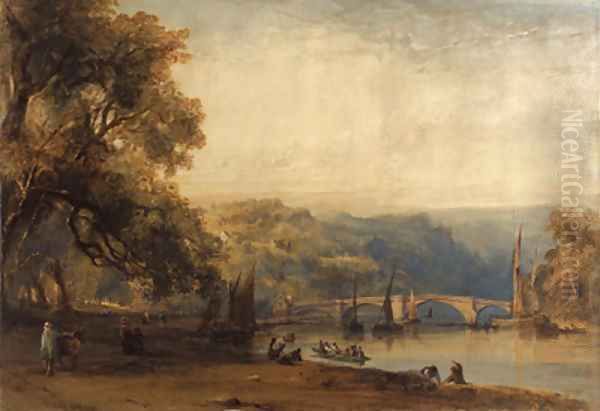
Positioned within the broader context of 19th-century art, Callow remained largely faithful to the established traditions of British landscape and watercolour painting, influenced by figures like Turner and Bonington. He did not engage significantly with the radical stylistic innovations of Impressionism or Post-Impressionism that emerged later in his career. His work aligns more closely with the detailed realism favoured during the Victorian era, often praised by critics like John Ruskin, although Callow's style retained a picturesque charm that perhaps looked back to the earlier Romantic period.
Later Years and Legacy
In 1846, William Callow married Harriet Anne Smart, who had been one of his pupils and was herself a talented artist. Harriet continued to paint after their marriage, sometimes exhibiting alongside her husband. The couple eventually settled in Great Missenden, Buckinghamshire, though Callow continued to travel and paint prolifically well into his old age. His dedication to his art remained unwavering throughout his long life. He also undertook teaching engagements, instructing members of the influential Rothschild family, further cementing his connections with prominent patrons.
William Callow died in Great Missenden in 1908, at the remarkable age of 95. By the time of his death, the art world had undergone significant changes, yet Callow's reputation as a master of traditional watercolour technique endured. While perhaps overshadowed during periods when modernist styles dominated critical attention, his work has consistently been held in high regard by collectors and connoisseurs of British watercolours. His paintings are represented in numerous public collections, including the Victoria and Albert Museum in London, the Yale Center for British Art, and the Johannesburg Art Gallery.
Callow and His Contemporaries
William Callow's career intersected with many key figures in 19th-century art. His early development was shaped by the Fielding brothers (Theodore and Newton) and profoundly influenced by Richard Parkes Bonington. His close friendship and collaboration with Thomas Shotter Boys in Paris were crucial. Upon returning to England, he joined the ranks of esteemed OWS members like David Cox and Peter De Wint, working within a tradition ultimately indebted to J.M.W. Turner. His focus on architectural and topographical subjects placed him alongside contemporaries such as Samuel Prout and David Roberts.
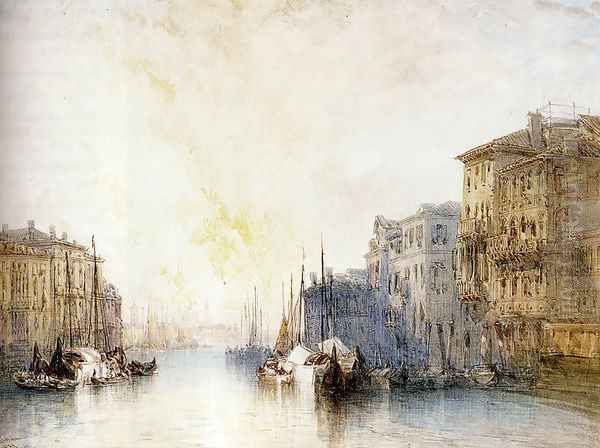
He fostered artistic talent through teaching, instructing royalty, patrons like the Rothschilds, and pupils including Charles Bentley (who became a friend and colleague) and his wife, Harriet Callow. While he adhered to a more traditional path compared to the later Impressionists, his long career saw him working alongside generations of artists, from the Romantics to later popular Victorian watercolourists like Myles Birket Foster. William Callow remains an important figure, representing the enduring strength and appeal of the British watercolour tradition throughout the Victorian age, admired for his technical brilliance, picturesque vision, and the extensive visual chronicle he created of the landscapes and cities of his time.